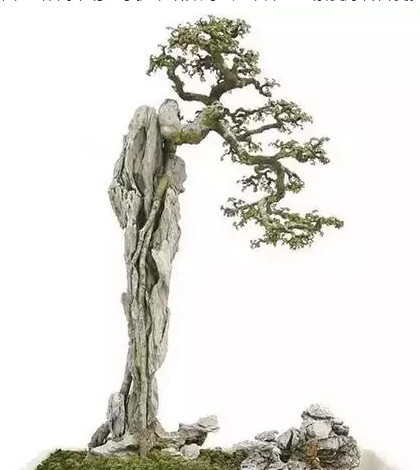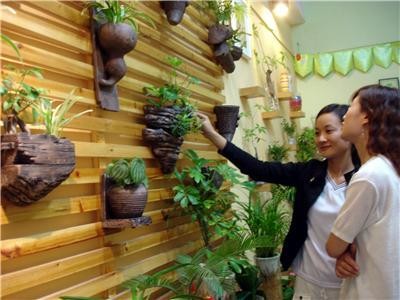Collection of pile scenery with stone bonsai
In general, the pile scene is to plant the stump directly in the basin soil, and its production and maintenance are relatively easy.
If the stump is like living on the stone and growing on the stone, it will be a stone-attached pile scene with special interest.
There are many kinds of ornamental stones, but the hard, non-absorbent rocks are generally not used, otherwise it is not easy to process, even if made, maintenance is also difficult.
Therefore, to do stone-attached pile scene, we must choose soft rocks that are easy to absorb water, such as sand stone, Reed stone, pumice and so on. There are two specific ways.
One is to carve a cave from the waist or top of the rock to its inner part, try to make the mouth and abdomen as big as a bottle, and then slowly put it into the culture soil.
While putting into the fibrous root of the stump and constantly stirring, do not make the stump curl up, to make the root soil close.
It is best to slightly modify the shape of the rocks and flatten the bottom of the rocks.
At this time, you can put it into a shallow basin filled with water, a basin with mountains and water, and the water-attached bonsai protruding from the rock is completed.
If it is a dry bonsai with stone, the basin will hold soil instead of water, and the rock can be chiseled up and down, so that the stump will pass through the cave, and part of the root will grow in the soil of the cave.
Most of the roots still grow in the basin soil, and from the location, it looks as if the tree stump has grown from stone.
Another method is to carve several to more than a dozen grooves on each side of the rocks, the direction of the grooves is either straight or oblique, and the spacing is the same, and the depth and width of the grooves should depend on the thickness of the tall tree roots.
After the rock grooves are finished, soak them in water for several days.
Then the side roots of the stump are embedded in the grooves of the rocks one by one, and the edges are temporarily fixed with adhesive tape.
After the root grooves are finished, the periphery is finally fixed with a few circles of fine lead wire, and the adhesive tape is removed.
Then seal the roots and rocks with river mud or thick pulp, and then wrap them with moss.
The fine root part of the root tip must still be straightened out and planted in the potted soil, and then the moss can be removed after about a year of careful maintenance.
After another year of maintenance, the river mud on the surface of the stone root was gradually washed clean due to watering and rain. At this time, the roots are close to the rocks, and the original fixed copper wire can also be removed. With the growth and adaptation of the stump, the roots gradually grow and thicken.
Although the main absorption part of the root system grows in the potted soil, the root clings to the boulder like a dragon's claw and grows tenaciously. It is very powerful, and it is beautiful in shape and profound in meaning.
Time: 2019-06-04 Click:
- Prev

Exquisite stone bonsai
The inheritance of Chinese bonsai art for more than a thousand years is known as three-dimensional painting and silent poetry. Bonsai with stone is the further inheritance and development of bonsai art. Stone players and bonsai lovers are deeply attracted by the perfect blending of stone and trees. In accordance with the usual practice, the following is to offer you exquisite bonsai with stone for your enjoyment.
- Next

The making method of Wall-mounted Landscape Bonsai
Wall-hanging landscape bonsai is generally based on marble or porcelain panels (the backplane can be framed or unframed) to create poetic landscapes with carefully selected and processed mountains and stones. Yingde stone, sand accumulation stone, stalagmite and so on are often used in mountains and stones.
Related
- Fuxing push coffee new agricultural production and marketing class: lack of small-scale processing plants
- Jujube rice field leisure farm deep ploughing Yilan for five years to create a space for organic food and play
- Nongyu Farm-A trial of organic papaya for brave women with advanced technology
- Four points for attention in the prevention and control of diseases and insect pests of edible fungi
- How to add nutrient solution to Edible Fungi
- Is there any good way to control edible fungus mites?
- Open Inoculation Technology of Edible Fungi
- Is there any clever way to use fertilizer for edible fungus in winter?
- What agents are used to kill the pathogens of edible fungi in the mushroom shed?
- Rapid drying of Edible Fungi

